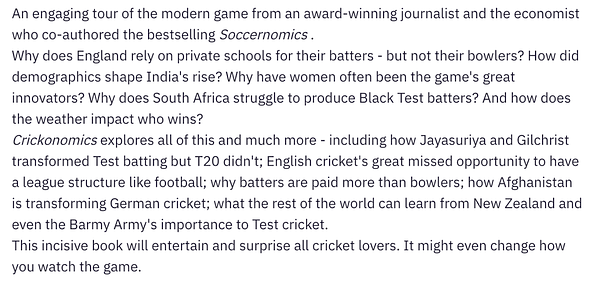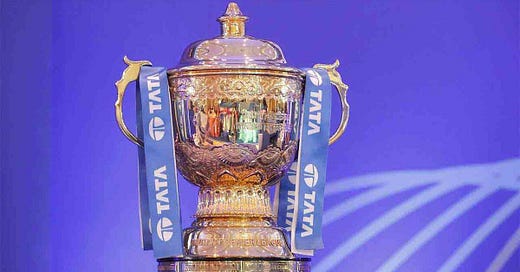The feature is almost done. Well, the next two features are almost done. Exciting stuff on Proteas players. But, because of research and everything involved in writing a good story, features take some time. In between writing, I have been reading Tim Wigmore and Stefan Szymanski’s new book, Crickonomics.



While we wait for the features, I have decided to share some thoughts on something.
Aviwe Mgijima top-scored for the SA Invitational team with 35. Sheldon Cottrell took a five-wicket haul, five for 16. Marlon Samuels faced 176 balls for his 203. Tabraiz Shamsi walked away with three wickets for 106. The match was played at Willowmoore Park, Benoni, in 2014.
It was a group of misfits. There were youngsters that selectors wanted to have a look at, like Gihan Cloete and Aviwe Mgijima. The team also had Proteas players who needed to prepare for the Test series, like Rory Kleinveldt and Stiaan van Zyl. Then you had players like Tabraiz Shamsi, players that no franchise team was going to miss after releasing their best players to the Proteas.
At the time, Shamsi was a replacement player for the Titans. He had just moved from KZN Inland on the strength of Grant Morgan’s recommendation and relationship with Rob Walter.
Shamsi made an impact immediately, he trapped Marlon Samuels lbw for 10 runs. He had him plumb. But Samuels was not given out. Maybe because the umpire felt that he needed more time in the middle or didn’t think he was out. Given the lifeline, Samuels punished the SA Invitational bowlers, he scored 203 runs off 176 balls.
“It's funny how things work,” says Shamsi. “I mean, during that innings, while he was facing me he probably said to himself, ‘Hey, this kid can bowl.’ If he were out after scoring only 10 runs, he wouldn't have been able to face me that much to reach that conclusion.”
Shamsi was at the top of his mark, preparing to bowl another delivery when Samuels approached him as a completed a single.
“Hey, would you like to play for my CPL team?” The big man asked Shamsi.
And just like that, Tabraiz Shamsi, the young player who didn’t start for his franchise, had bowled his way to a CPL contract.
Tabraiz Shamsi's case was a rarity in the 2010s. It is probably the extreme. A player's attractiveness to franchise leagues worldwide was driven by performance in international cricket. International cricket was the gateway to T20 leagues. Without international cricket, agents worked incredibly hard to get their clients noticed. Rassie van der Dussen's agent certainly worked hard to get Rassie into the Canadian T20 league before he debuted for South Africa.
That looks like a lifetime ago now. Dewald Brevis broke into the IPL before turning out for SA A. I don’t think Under-19 counts as international cricket. Add Tristan Stubbs and Marco Jansen to the list. Last year, Ryan Rickelton could have debuted in the UAE T10 league before his international debut, everything was on track for that. Then he got called up to the One Day squad.
For a brief moment, T20 leagues were seen as the last stop before retirement. Players on their way out had a last-ditch effort to maximise their earning potential before drifting into retirement. One final effort to add to the nest egg. The rise of free agents changed that. Younger players from around the world entered the fray. Players could earn a living, sometimes earning more than international cricketers by being on the T20 circuit.
Now, T20 leagues have a different pathway. Players can start with the lesser lucrative leagues and use them as a ladder to the top; IPL, PSL, CPL. Leagues and franchises with better financing now have scouts trawling domestic leagues for talent. The tables are turning. It won’t be long before national scouts start keeping an eye on global leagues for international talent. Finally, cricket is on its way to becoming like the rest of the sporting world.
Franchise leagues will sustain cricket in the future. The same way it is in football. But cricket seems to be on a slightly different path to football, the IPL is looking to take centre stage.
“The IPL will become more like the NBA,” Tim Wigmore told me in January 2021.
NBA teams play 82 matches per season and the tournament runs for six months. Currently, IPL teams play 14 matches each over two months. After IPL15, IPL16 - the 2023 edition - will be a step in that direction. IPL16 will be longer, most likely a 94-match tournament. That will not be the last of IPL growth. More matches and more teams playing home and away matches mean a likelihood of a four-month-long IPL or longer.
According to Bharat Sundaresan, the BCCI is approaching ICC for a longer window. It might not result in one continuous IPL window, there is talk of a summer and winter IPL. Two windows for the league.

Stumped! is a reader-supported newsletter. Those who opt to buy coffees or become patrons are taking an active role in the work that I do by providing vital assistance to bolster my independent coverage of cricket. Feel free to forward this post to family and friends interested in cricket and/or cricketers.
Buttons are at the bottom of the article.
Before the IPL, international cricket had a 12-month window to navigate. In the past few years, that window has shrunk to 10 months.
‘At the end of 2017, the ICC effectively granted a global window to the IPL, with the new Future Tours Programme avoiding clashes between leading international fixtures and the IPL,’ Tim Wigmore and Stefan Szymanski write in their book, Crickonomics: The Anatomy of Modern Cricket.
Two IPL windows, of two months each, would shrink the window further to eight months. That’s eight months for non-IPL cricket events. In the years when there are ICC events, that means a shorter time for bilateral matches and local franchise leagues.
India and the BCCI would not mind an ever-expanding IPL. India is not reliant on international cricket for money like the rest of the cricketing world. India is not like CSA. CSA needs more home internationals against India, England and Australia to keep afloat. A four-match home T20 series against India would earn CSA about $200 million.
CSA requires $750 million or more to run the game in South Africa. The domestic game does not provide revenue, at least not enough to sustain the game.
It's easy to see why the BCCI would want a longer IPL. Wigmore and Szymanski reveal that from 2018 onwards, the BCCI earned 71% of its broadcasting rights revenue from the league. India could stop playing international cricket, the BCCI would not feel the lost revenue.
From 2016 to 2023, the BCCI's share of income from the ICC's global events is a meagre $50 million a year. Compare that to the multibillion-dollar broadcasting rights deal the IPL is likely to sign in the next cycle. The percentage of BCCI earnings from the IPL will rise.
A longer IPL would mean less time for international cricket and other franchise leagues. No one wants to schedule matches in the same window as the IPL and play second fiddle.
‘Should boards now have the temerity to compete with the IPL, they will look second-rate in comparison: players, fan interest and broadcasting dollars will all gravitate to the IPL,” Wigmore and Szymanski write.
Unlike the BCCI which earns from the IPL, CSA used money earned from international cricket to bankroll the now-defunct Mzansi Super League.
The new ‘yet-to-be-named-league’ looks to be different. It will have private investors. Five of those investors will be IPL franchises, according to the rumour mill. This follows a trend. The six franchises in the Caribbean Premier League are owned by Indian investors. Three of those six, Trinibago Knight Riders, Barbados Royals and St. Lucia Kings are owned by IPL investors, Kolkata Knight Riders, Rajasthan Royals and Punjab Kings.
In the face of an ever-growing IPL, private investors would demand that leagues such as the CPL and CSA’s ‘yet-to-be-named-league’ be given the prime slot in the IPL-free window. They would also want assurances on the availability of the country’s best players. Where will this leave international cricket?
Thank you for reading. I am entirely freelance and some very nice people help me to continue producing more content by donating a little here and there. Some do so by supporting my work on Patreon.
Others prefer to buy me a coffee, or multiple coffees:
Others also support by sharing posts that they enjoy. You can do all three.




